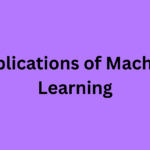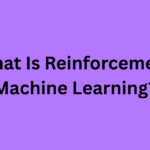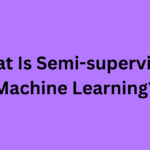Machine Learning (ML) is a branch of artificial intelligence (AI) that empowers computers to learn from data, identify patterns, and make decisions without explicit programming. It bridges the gap between data and actionable insights, driving innovations across industries.
What is Machine Learning?
ML systems improve automatically through experience, using algorithms to analyze data, learn from it, and make predictions or decisions.
- Features: Input variables (e.g., age, income).
- Labels: Output variables (e.g., “spam” or “not spam”).
- Training: Teaching a model using historical data.
- Inference: Using the trained model to predict outcomes.
How It Works:
Traditional Programming: Input + Rules → Output
Machine Learning: Input + Output → Rules

Components:
- Data: Clean, labeled, and representative datasets.
- Model: Mathematical representation of patterns (e.g., neural networks).
- Algorithm: Procedure to train the model (e.g., gradient descent).
Types of Machine Learning:
A.) Supervised Learning
-
Supervised Learning Predict outcomes using labeled data.
-
Examples:
-
Regression: Predict continuous values (e.g., house prices with Linear Regression).
-
Classification: Assign discrete labels (e.g., email spam detection with Logistic Regression).
-
B.) Unsupervised Learning
-
Unsupervised Learning Find patterns in unlabeled data.
-
Examples:
-
Clustering: Group similar data (e.g., customer segmentation with K-Means).
-
Dimensionality Reduction: Simplify data (e.g., PCA for visualizing high-dimensional data).
-
C.) Reinforcement Learning (RL)
-
Train agents to maximize rewards through trial and error.
-
Examples:
-
Game-playing AI (e.g., AlphaGo).
-
Robotics control systems.
-
Examples of Machine Learning:
1.) Supervised:
-
Email Spam Filter: Trained on emails labeled “spam” or “not spam” to classify new emails.
-
House Price Prediction: Uses features like square footage and location to predict prices.
2.) Unsupervised:
-
Customer Segmentation: Groups users based on purchasing behavior.
-
Anomaly Detection: Flags fraudulent transactions in banking data.
3.) Reinforcement:
-
Self-Driving Cars: Learn to navigate by receiving rewards for safe driving.
-
Chess AI: Improves strategy by playing millions of games.
Applications of Machine Learning:
ML is revolutionizing industries through automation and predictive capabilities:
1.) Healthcare:
-
Disease diagnosis (e.g., cancer detection in medical imaging).
-
Drug discovery (e.g., predicting molecular interactions).
2.) Finance:
-
Fraud detection (e.g., identifying suspicious transactions).
-
Algorithmic trading (e.g., predicting stock trends).
3.) Retail:
-
Recommendation systems (e.g., Amazon’s “customers also bought”).
-
Inventory management using demand forecasting.
4.) Technology:
-
Natural Language Processing (NLP) (e.g., ChatGPT).
-
Computer vision (e.g., facial recognition in smartphones).
Challenges of Machine Learning:
1. Data Integrity
Challenge: “Flawed input, flawed output” -: Inaccurate, incomplete, or skewed datasets undermine model reliability and fairness.
Impact: Errors or systemic biases in training data propagate into flawed predictions (e.g., facial recognition failing on underrepresented groups).
2. Overfitting Issues
Challenge: Models become overly specialized to training data, losing the ability to generalize to new, unseen scenarios.
Impact: High accuracy on training data but poor real-world performance (e.g., a stock prediction model failing during market volatility).
3. Ethical Risks
Challenge: Algorithmic discrimination (e.g., gender or racial bias in hiring tools) and data privacy breaches.
Impact: Erosion of trust, legal repercussions, and harm to marginalized communities.
Systems can learn, adapt, and solve complicated issues thanks to machine learning, a game changing technology. Its uses are numerous and expanding, ranging from life saving medical devices to tailored recommendations.








This platform makes learning easy and engaging excellent content, user-friendly interface, and flexible access anytime. Highly recommend for all learners
Thank you so much for your kind words! We’re thrilled to hear you’re enjoying the platform happy learning! 😊